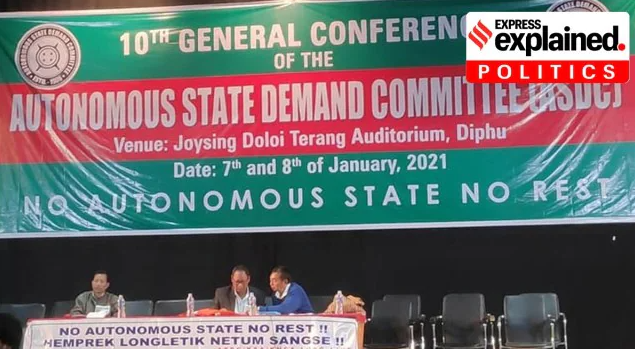 |
| Article 244(A) and Tribal Autonomy in Assam's Diphu [Image Source: The Indian Express] |
In the recent Lok Sabha elections, the Diphu constituency in Assam, predominantly inhabited by tribal communities, witnessed a significant electoral focus on the implementation of Article 244(A) of the Indian Constitution. This constitutional provision offers the possibility of creating an autonomous state within Assam, providing greater autonomy to tribal regions. Here are the key points surrounding this issue:
Diphu Constituency Overview:
Diphu, designated for Scheduled Tribes (STs), is the least populated among Assam's 14 Lok Sabha seats, with approximately 8.9 lakh voters. It comprises six Assembly segments spread across three tribal-majority hill districts: Karbi Anglong, West Karbi Anglong, and Dima Hasao. These districts fall under the governance of the Sixth Schedule of the Constitution and are administered by two autonomous councils—the Karbi Anglong Autonomous Council (KAAC) and the North Cachar Hills Autonomous Council. The constituency is home to a diverse array of communities, including Karbi, Dimasa, Hmar, Kuki, Rengma Naga, Zeme Naga, Bodo, Garo, Assamese, and Gorkha.
Article 244(A):
- Introduced by the 22nd Amendment Act of 1969, Article 244(A) empowers the Parliament to establish an autonomous state within Assam for specific tribal areas.
- It allows for the creation of a separate legislature, council of ministers, and offers increased autonomy over law and order.
- The demand for autonomy in Assam's hill areas, such as Karbi Anglong, traces back to the 1950s, culminating in several militant groups signing peace accords with the government to secure the implementation of Article 244(A).
- Key features of Article 244(A) include provisions for a separate Legislature or Council of Ministers, which exceed the limited powers granted to autonomous councils under the Sixth Schedule, granting greater control over law and order and financial matters.
History of Autonomy Demand:
- The demand for autonomy in Assam's hill areas has a longstanding history, originating in the 1950s with a movement for a separate hill state.
- Despite the creation of Meghalaya in 1972, leaders in Karbi Anglong opted to remain within Assam, relying on the promise of Article 244(A).
- The Autonomous State Demand Committee (ASDC), advocating for regional autonomy, played a pivotal role in negotiating a Memorandum of Settlement in 1995 with state and central governments to enhance the powers of the two autonomous councils in the region.
- However, as autonomy remained elusive, the demand for Article 244(A) manifested into an armed insurgency, leading to peace accords between the governments in Delhi and Guwahati and militant groups, including the Karbi and Dimasa factions.
- Recent peace settlements, such as the 2021 agreement with five militant groups in Karbi Anglong and a similar accord with the Dimasa National Liberation Army in 2023, promise greater autonomy and special development packages.
- Despite these agreements, the implementation of Article 244(A) continues to be a central issue in the Diphu constituency, with all candidates pledging to work towards realizing this constitutional provision, which remains a longstanding demand of tribal communities in the region.
